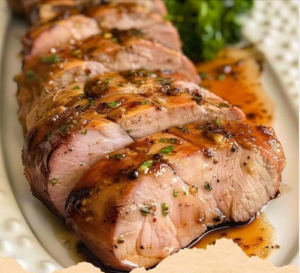
Here are the secrets to guide you towards a delicious dish:
Preparation and Seasoning
- Quality Pork Tenderloin: Start with a good quality pork tenderloin for the best flavor and texture.
- Trimming: Remove any excess fat or silver skin from the pork tenderloin before cooking to ensure even cooking and a nicer presentation.
- Even Thickness: If the pork tenderloin varies in thickness, consider using a meat mallet to gently pound it to an even thickness. This promotes even cooking.
- Seasoning: Season the pork generously with salt and pepper before applying the Dijon mustard and brown sugar glaze. This enhances the flavor of the meat.
Glazing and Cooking
- Marinating Time: For deeper flavor, marinate the pork tenderloin in the Dijon mustard and brown sugar mixture for at least 30 minutes, or up to overnight in the refrigerator.
- Room Temperature: Allow the marinated pork tenderloin to come to room temperature before cooking. This ensures more even cooking.
- Searing: Sear the pork tenderloin in a hot skillet before baking. This caramelizes the exterior, adding flavor and texture.
- Baking Temperature: Bake the pork tenderloin at a moderate temperature (around 400°F/200°C) to ensure it cooks through evenly without drying out.
- Use a Meat Thermometer: Invest in a meat thermometer to accurately gauge when the pork tenderloin reaches an internal temperature of 145°F (63°C), ensuring it’s perfectly cooked and safe to eat.
- Resting Time: Allow the pork tenderloin to rest for at least 5 minutes after cooking before slicing. This allows the juices to redistribute, resulting in a juicier and more flavorful dish.
Flavor Enhancements
- Garlic Infusion: Add minced garlic to the Dijon mustard and brown sugar glaze for an extra layer of flavor.
- Herb Addition: Sprinkle dried herbs like thyme, rosemary, or sage over the pork before baking to enhance the aroma and taste.
- Citrus Zest: Consider adding a pinch of citrus zest (lemon or orange) to the glaze for a bright, refreshing note.
- Spice Adjustment: Adjust the amount of brown sugar in the glaze to balance the sweetness with the tanginess of the Dijon mustard, based on your preference.
Serving and Presentation
- Slicing Technique: Slice the pork tenderloin against the grain into medallions for a tender bite.
- Garnishing: Garnish the sliced pork tenderloin with freshly chopped parsley or chives for a pop of color and freshness.
- Serving Temperature: Serve the pork tenderloin warm, accompanied by the Brown Sugar Dijon dipping sauce on the side.
- Pairing: Choose sides that complement the flavors of the pork tenderloin, such as roasted vegetables, mashed potatoes, or a simple green salad.
Kitchen Tips
- Preheating the Oven: Ensure your oven is fully preheated to the specified temperature before baking the pork tenderloin.
- Oven Positioning: Position the oven rack in the center of the oven for even heat distribution around the pork tenderloin.
- Basting: If desired, baste the pork tenderloin with the pan juices halfway through baking to keep it moist.
- Aluminum Foil Tent: Tent the cooked pork tenderloin loosely with aluminum foil while it rests to keep it warm without trapping steam.
Ingredient Selection
- Mustard Varieties: Experiment with different types of Dijon mustard (whole grain, spicy, etc.) to find the flavor profile you prefer.
- Mayonnaise Quality: Use a good quality mayonnaise for the dipping sauce to ensure a creamy and rich texture.
Technique Refinement
- Sauce Consistency: Adjust the amount of mayonnaise and brown sugar in the dipping sauce to achieve your desired consistency and sweetness.
- Cooking Vessel: Choose an oven-proof skillet or baking dish that comfortably fits the pork tenderloin without overcrowding.
- Brushing Technique: Use a pastry brush to evenly coat the pork tenderloin with the Dijon mustard and brown sugar glaze for a uniform flavor.
Flavor Balance
- Taste Testing: Taste the glaze before applying it to the pork tenderloin to ensure it has the right balance of sweet and tangy flavors.
- Seasoning Throughout: Ensure every part of the pork tenderloin is seasoned, including the ends, for consistent flavor.
Equipment Utilization
- Meat Resting: Allow the pork tenderloin to rest on a cutting board or serving platter to allow excess juices to drain before slicing.
- Cleaning Surface: Clean and disinfect all surfaces that have come into contact with raw pork tenderloin before serving.
